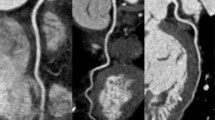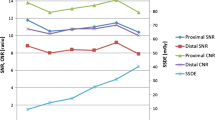Abstract
Objectives
To assess radiation dose and image quality of coronary computed tomography angiography (cCTA) with a third-generation dual-source scanner in a real-world patient population.
Methods
Scans of otherwise unselected, consecutive patients referred for clinically indicated cCTA between June 2015 and November 2017 were included for retrospective analysis. Scan protocol was based on heart rate: prospectively ECG-gated high-pitch spiral below 60 beats per minute (bpm), prospectively ECG-gated sequential scan between 61 and 70 bpm, and retrospective spiral above 70 bmp or at irregular heart rates. Objective image quality was measured as signal-to-noise (SNR) and contrast-to-noise ratio (CNR); subjective image quality was evaluated using a five-point Likert scale by two independent readers. For radiation dose analysis, effective dose, size-specific dose estimates, and volume CT dose index were assessed.
Results
Two hundred seventy-eight patients (median age, 60 years; 155 men) with a median body mass index of 26.6 kg/m2 (range, 16.7–60.9 kg/m2; 180 (64.7%) overweight or obese) were included (122 in the high-pitch spiral group, 60 in the prospective sequence group, and 96 in the retrospective spiral group). Median effective dose was 0.63 mSv (interquartile range [IQR], 0.51–0.90 mSv) for high-pitch spiral, 1.32 mSv (IQR, 0.79–2.46 mSv) for prospective sequence, and 4.77 (IQR, 3.02–8.27 mSv) for retrospective spiral (p < 0.001). Most studies had at least very good image quality (91.4/88.8% R1/R2), with highest SNR and CNR in the high-pitch spiral group.
Conclusions
cCTA with sufficient image quality is achievable at reasonably low radiation exposure in a real-world patient collective with a high proportion of overweight or obese patients.
Key Points
• Submillisievert radiation dose coronary CT angiography with good diagnostic image quality is feasible in the majority of cases in a real-world patient using high-pitch spiral.
• Prospective sequence results in about double median effective dose compared to the high-pitch protocol.
• To optimize individual radiation exposure, lowering the heart rate is paramount, as it allows for choosing a dose-optimized (high-pitch spiral) scan protocol.


Similar content being viewed by others
Abbreviations
- CAD:
-
Coronary artery disease
- cCTA:
-
Coronary computed tomography angiography
- CNR:
-
Contrast-to-noise ratio
- CT:
-
Computed tomography
- CTDIvol :
-
Volume computed tomography dose index
- DLP:
-
Dose-length product
- ECG:
-
Electro cardiogram
- ROI:
-
Region of interest
- SNR:
-
Signal-to-noise ratio
- SSDE:
-
Size-specific dose estimates
References
Leschka S, Stolzmann P, Desbiolles L et al (2009) Diagnostic accuracy of high-pitch dual-source CT for the assessment of coronary stenoses: first experience. Eur Radiol 19:2896–2903. https://doi.org/10.1007/s00330-009-1618-9
Husmann L, Schepis T, Scheffel H et al (2008) Comparison of diagnostic accuracy of 64-slice computed tomography coronary angiography in patients with low, intermediate, and high cardiovascular risk. Acad Radiol 15:452–461. https://doi.org/10.1016/j.acra.2007.12.008
Moss AJ, Williams MC, Newby DE, Nicol ED (2017) The updated NICE guidelines: cardiac CT as the first-line test for coronary artery disease. Curr Cardiovasc Imaging Rep 10:15. https://doi.org/10.1007/s12410-017-9412-6
Rybicki FJ, Udelson JE, Peacock WF et al (2016) 2015 ACR/ACC/ AHA/AATS/ACEP/ASNC/NASCI/SAEM/SCCT/SCMR/SCPC/ SNMMI/STR/STS Yinappropriate utilization of cardiovascular imaging in emergency department patients with chest pain:A joint document of the American College of Radiology Appropriateness Criteria Committee and the American College of Cardiology Appropriate Use Criteria Task Force. J Am Coll Cardiol 67:853–879. https://doi.org/10.1016/j.jacc.2015.09.011
Montalescot G, Sechtem U, Achenbach S et al (2013) 2013 ESC guidelines on the management of stable coronary artery disease: the task force on the management of stable coronary artery disease of the European Society of Cardiology. Eur Heart J 34:2949–3003. https://doi.org/10.1093/eurheartj/eht296
Goldstein JA, Chinnaiyan KM, Abidov A et al (2011) The CT-STAT (coronary computed tomographic angiography for systematic triage of acute chest pain patients to treatment) trial. J Am Coll Cardiol 58:1414–1422. https://doi.org/10.1016/j.jacc.2011.03.068
Hoffmann U, Truong QA, Schoenfeld DA et al (2012) Coronary CT angiography versus standard evaluation in acute chest pain. N Engl J Med 367:299–308. https://doi.org/10.1056/NEJMoa1201161
Litt HI, Gatsonis C, Snyder B et al (2012) CT angiography for safe discharge of patients with possible acute coronary syndromes. N Engl J Med 366:1393–1403. https://doi.org/10.1056/NEJMoa1201163
Abbara S, Arbab-Zadeh A, Callister TQ et al (2009) SCCT guidelines for performance of coronary computed tomographic angiography: a report of the Society of Cardiovascular Computed Tomography Guidelines Committee. J Cardiovasc Comput Tomogr 3:190–204. https://doi.org/10.1016/j.jcct.2009.03.004
Halliburton SS, Abbara S, Chen MY et al (2011) SCCT guidelines on radiation dose and dose-optimization strategies in cardiovascular CT. J Cardiovasc Comput Tomogr 5:198–224. https://doi.org/10.1016/j.jcct.2011.06.001
Yin WH, Lu B, Hou ZH et al (2013) Detection of coronary artery stenosis with sub-milliSievert radiation dose by prospectively ECG-triggered high-pitch spiral CT angiography and iterative reconstruction. Eur Radiol 23:2927–2933. https://doi.org/10.1007/s00330-013-2920-0
Brenner DJ, Hall EJ (2007) Computed tomography — an increasing source of radiation exposure. N Engl J Med 357:2277–2284. https://doi.org/10.1056/NEJMra072149
Einstein AJ, Henzlova MJ, Rajagopalan S (2007) Estimating risk of cancer associated with radiation exposure from 64-slice computed tomography coronary angiography. JAMA 298:317–323. https://doi.org/10.1001/jama.298.3.317
Einstein AJ (2012) Effects of radiation exposure from cardiac imaging. J Am Coll Cardiol 59:553–565. https://doi.org/10.1016/j.jacc.2011.08.079
Hausleiter J, Meyer T, Hadamitzky M et al (2006) Radiation dose estimates from cardiac multislice computed tomography in daily practice: impact of different scanning protocols on effective dose estimates. Circulation 113:1305–1310. https://doi.org/10.1161/CIRCULATIONAHA.105.602490
Apfaltrer G, Szolar DH, Wurzinger E et al (2017) Impact on image quality and radiation dose of third-generation dual-source computed tomography of the coronary arteries. Am J Cardiol 119:1156–1161. https://doi.org/10.1016/j.amjcard.2016.12.028
Meyer M, Haubenreisser H, Schoepf UJ et al (2014) Closing in on the K edge: coronary CT angiography at 100, 80, and 70 kV—initial comparison of a second- versus a third-generation dual-source CT system. Radiology 273:373–382. https://doi.org/10.1148/radiol.14140244
Schuhbaeck A, Achenbach S, Layritz C et al (2012) Image quality of ultra-low radiation exposure coronary CT angiography with an effective dose < 0.1 mSv using high-pitch spiral acquisition and raw data-based iterative reconstruction. Eur Radiol 23:597–606. https://doi.org/10.1007/s00330-012-2656-2
Agatston AS, Janowitz WR, Hildner FJ, Zusmer NR, Viamonte M Jr, Detrano R (1990) Quantification of coronary artery calcium using ultrafast computed tomography. J Am Coll Cardiol 15:827–832. https://doi.org/10.1016/0735-1097(90)90282-T
Higashigaito K, Husarik DB, Barthelmes J et al (2016) Computed tomography angiography of coronary artery bypass grafts. Investig Radiol 51:241–248. https://doi.org/10.1097/RLI.0000000000000233
(2007) The 2007 recommendations of the international commission on radiological protection. ICRP publication 103. Ann ICRP 37:1–332. https://doi.org/10.1016/j.icrp.2007.10.003
Boone JM, Strauss KJ, Cody DD et al (2011) Size-specific dose estimates (SSDE) in pediatric and adult body CT examinations. American Association of Physicists in Medicine, College Park
Koo TK, Li MY (2016) A guideline of selecting and reporting Intraclass correlation coefficients for reliability research. J Chiropr Med 15:155–163. https://doi.org/10.1016/j.jcm.2016.02.012
Bischoff B, Hein F, Meyer T et al (2009) Impact of a reduced tube voltage on CT angiography and radiation dose: results of the PROTECTION I study. JACC Cardiovasc Imaging 2:940–946. https://doi.org/10.1016/j.jcmg.2009.02.015
Feuchtner GM, Jodocy D, Klauser A et al (2010) Radiation dose reduction by using 100-kV tube voltage in cardiac 64-slice computed tomography: a comparative study. Eur J Radiol 75:e51–e56. https://doi.org/10.1016/j.ejrad.2009.07.012
Hausleiter J, Martinoff S, Hadamitzky M et al (2010) Image quality and radiation exposure with a low tube voltage protocol for coronary CT angiography. JACC Cardiovasc Imaging 3:1113–1123. https://doi.org/10.1016/j.jcmg.2010.08.016
Labounty TM, Leipsic J, Poulter R et al (2011) Coronary CT angiography of patients with a normal body mass index using 80 kVp versus 100 kVp: a prospective, multicenter, multivendor randomized trial. AJR Am J Roentgenol 197:W860–W867. https://doi.org/10.2214/AJR.11.6787
Cao J-X, Wang Y-M, Lu J-G et al (2014) Radiation and contrast agent doses reductions by using 80-kV tube voltage in coronary computed tomographic angiography: a comparative study. Eur J Radiol 83:309–314. https://doi.org/10.1016/j.ejrad.2013.06.032
Oda S, Utsunomiya D, Funama Y et al (2011) A low tube voltage technique reduces the radiation dose at retrospective ECG-gated cardiac computed tomography for anatomical and functional analyses. Acad Radiol 18:991–999. https://doi.org/10.1016/j.acra.2011.03.007
Komatsu S, Kamata T, Imai A et al (2013) Coronary computed tomography angiography using ultra-low-dose contrast media: radiation dose and image quality. Int J Cardiovasc Imaging 29:1335–1340. https://doi.org/10.1007/s10554-013-0201-2
Kalva SP, Sahani DV, Hahn PF, Saini S (2006) Using the K-edge to improve contrast conspicuity and to lower radiation dose with a 16-MDCT. J Comput Assist Tomogr 30:391–397. https://doi.org/10.1097/00004728-200605000-00008
Ogden CL, Carroll MD, Kit BK, Flegal KM (2014) Prevalence of childhood and adult obesity in the United States, 2011-2012. JAMA 311:806. https://doi.org/10.1001/jama.2014.732
Gordic S, Desbiolles L, Sedlmair M et al (2015) Optimizing radiation dose by using advanced modelled iterative reconstruction in high-pitch coronary CT angiography. Eur Radiol:1–10. https://doi.org/10.1007/s00330-015-3862-5
Mangold S, Wichmann JL, Schoepf UJ et al (2016) Automated tube voltage selection for radiation dose and contrast medium reduction at coronary CT angiography using 3rd generation dual-source CT. Eur Radiol:1–9. https://doi.org/10.1007/s00330-015-4191-4
Funding
The authors state that this work has not received any funding.
Author information
Authors and Affiliations
Corresponding author
Ethics declarations
Guarantor
The scientific guarantor of this publication is Tobias Gassenmaier.
Conflict of interest
The authors declare that they have no conflict of interest.
Statistics and biometry
No complex statistical methods were necessary for this paper.
Informed consent
Written informed consent was obtained from all subjects (patients) in this study.
Ethical approval
Institutional Review Board approval was obtained.
Methodology
• Retrospective
• Observational
• Performed at one institution
Rights and permissions
About this article
Cite this article
Kosmala, A., Petritsch, B., Weng, A.M. et al. Radiation dose of coronary CT angiography with a third-generation dual-source CT in a “real-world” patient population. Eur Radiol 29, 4341–4348 (2019). https://doi.org/10.1007/s00330-018-5856-6
Received:
Revised:
Accepted:
Published:
Issue Date:
DOI: https://doi.org/10.1007/s00330-018-5856-6




